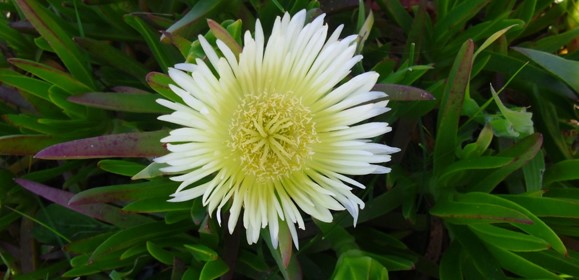
Perennial creeping subshrub, with very fleshy leaves and large pink or yellow flowers.
Sceintific name: Carpobrotus edulis (L.) N. E. Br.
Common names: ice plant, iceplant, highway iceplant, Hottentot fig, sea fig
Family: Aizoaceae
Status in Portugal: invasive species (listed in the Decreto-Lei nº 92/2019, 10 july)
Risk Assessment score: 23 | Value obtained according to a protocol adapted from the Australian Weed Risk Assessment (Pheloung et al. 1999), by Morais et al. (2017), according to which values above 13 mean that the species has risk of having invasive behavior in the Portuguese territory | Updated on 30/09/2017.
Synonymy: Mesembryanthemum edule L.
Last update: 14/04/2021
How to recognise it
Perennial creeping subshrub , succulent,with stems that may reach several meters, and rooting from their nodes.
Leaves: fleshy, erect or erect-patent, oblong, with 4-13 x 1-1,6 cm with an equilateral triangular cross section and an acute apex.
Flowers: from 8-10 cm diameter, solitary, yellow or pink/purple; yellow stamens.
Fruits: fleshy, with an ovoid shape, edible. Initially, they are green, becoming purple in maturation, staying on the plant for many months. The seeds, very small (1 mm long), are black.
Flowering: March to June.
Similar species
Carpobrotus acinaciformis (L.) L. Bolus (elands sourfig) is similar, but the leaves have an isosceles triangular cross section.
Characteristics that aid invasion
It propagates vegetatively by fragments, sprouting vigorously after cutting.
It also reproduces by seed, producing many seeds (each fruit has between 1000 and 1800 seeds), which are dispersed by small mammals.
Native distribution area
South Africa (Cape Region).
Distribution in Portugal
Mainland Portugal (Minho, Trás-os-Montes, Douro Litoral, Beira Litoral, Estremadura, Alto Alentejo, Baixo Alentejo, Algarve), Azores archipelago (all islands), Madeira archipelago (Madeira and Porto Santo islands).
Geographic areas where there are records of Carpobrotus edulis
Other places where the species is invasive
Southern Europe (Spain and France), western USA (California), New Zealand, North Africa.
Introduction reasons
For ornamental purposes. Frequently cultivated in the past, to stabilise dunes and slopes.
Preferential invasion environments
Coastal dunes, dunar belts and areas near the slopes where it was planted.
It thrives both in dry areas and in humid ones.
Impacts on ecosystems
It forms impenetrable mats that cover extensive areas, hampering the development of native vegetation.
It promotes soil acidification, a process that favours its own growth.
Economic impacts
High costs in applying control methodologies.
Natura 2000 Network habitats more subject to impacts
– Vegetated sea cliffs of the Atlantic and Baltic coasts (1230);
– Vegetated sea cliffs of the Mediterranean coasts with endemic Limonium spp. (1240);
– Shifting dunes along the shoreline with Ammophila arenaria («white dunes») (2120);
– Fixed coastal dunes with herbaceous vegetation («grey dunes») (2130);
– Atlantic decalcified fixed dunes (Calluno-Ulicetea) (2150);
– Dunes with Salix repens ssp. argentea (Salicion arenariae) (2170);
– Humid dune slacks (2190);
– Malcolmietalia dune grasslands (2230);
– Coastal dunes with Juniperus spp. (2250);
– Cisto-Lavenduletalia dune sclerophyllous scrubs (2260);
– Wooded dunes with Pinus pinea and/or Pinus pinaster (2270);
– Inland dunes with open Corynephorus and Agrostis grasslands (2330);
– Cistus palhinhae formations on maritime wet heaths (5140);
– West Mediterranean clifftop phryganas (Astragalo-Plantaginetum subulatae) (5410).
Controlling an invasive species demands a well-planned management, which includes the determination of the invaded area, identifying the causes of invasion, assessing the impacts, defining the intervention priorities, selecting the adequate control methodologies and their application. Afterwards it is fundamental to monitor the efficiency of the methodologies and recuperation of the intervened area as to perform, whenever necessary, the follow-up control.
The control methodologies used for Carpobrotus edulis include:
Physical control
Hand pulling (preferencial methodology). In sandy substrates, where it is most frequent, hand pulling is normally easy at any time. In more compacted substrates, hand pulling must be during the rainy season as to facilitate the removal of the root system. It should be guaranteed that there are no large fragments left in the ground, which root easily and originate new invasion foci.
After being hand pulled, the plants should be removed to a “safe” place, where they are left to dry, preferentially covered in a black plastic as to accelerate their destruction/degradation. Alternatively, they may be left on site, but with the roots faced up, without any contact with the substrate.
Chemical control
Foliar application of herbicide. Spray with herbicide (active principle: glyphosate) limiting the exposure to the target species.
Visit the webpage How to Control for additional and more detailed information about the correct application of these methodologies.
CABI (2012) Carpobrotus edulis. In: invasive">Invasive species">Species Compendium. CAB International, Wallingford, UK. Available: http://www.cabi.org/isc/ [Retrieved 10/11/2012].
Dana ED, Sanz-Elorza M, Vivas S, Sobrino E (2005) Especies vegetales invasoras en Andalucía. Consejería de Medio Ambiente, Junta de Andalucía, Sevilla, 233pp.
Dufour-Dror J-M (2012) Alien invasive plants in Israel. The Middle East Nature Conservation Promotion Association, Ahva, Jerusalem, 213pp.
Fernandes FM, Osório VEM, Silva L (2008) Carpobrotus edulis (L.) N. E. Br. In: Silva L, Land EO, Luengo JLR (eds) Flora e fauna terrestre invasora na Macaronésia. Top 100 nos Açores, Madeira e Canárias. Arena, Ponta Delgada, pp. 197-200.
Marchante E, Freitas H, Marchante H (2008) Guia prático para a identificação de plantas invasoras de Portugal Continental. Imprensa da Universidade de Coimbra, Coimbra, 183pp.



